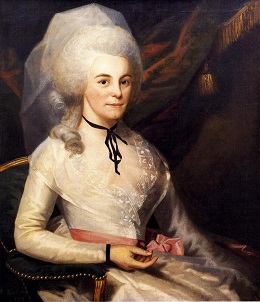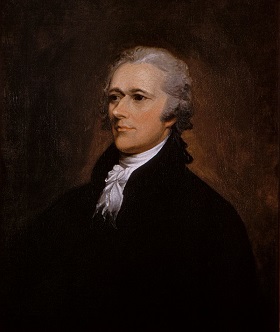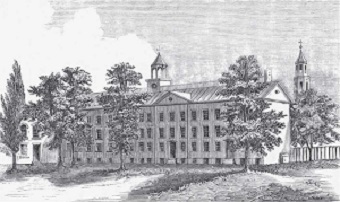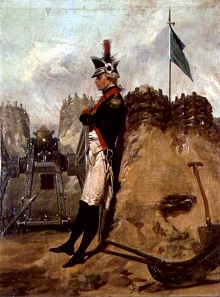Who Served Here?
Alexander Hamilton
Alexander Hamilton was born in Charlestown, Nevis, in the West Indies on January 11, 1757 (or 1755), to James Hamilton, a Scottish merchant of St. Christopher, and Rachel Fawcett. Rachel's father was a Huguenot physician and planter. While very young, she had been married to and divorced from a Danish proprietor on St. Croix. After her divorce, the court prohibited her remarriage. The marriage to James Hamilton was acceptable socially in the West Indies, but not elsewhere. The union resulted in the birth of two sons, but they were living apart less than 10 years later. Rachel and her boys lived on St. Croix, dependent on her relatives. She passed away in 1768. His father survived until 1799 — but the boys were virtually orphans before they were even teenagers.
At the age of 12, Hamilton began work as a clerk in a general store, but the boy had a keen intellect and ambitious goals. He was an excellent writer, in French as well as English. In 1772, a hurricaine ravaged the West Indies. Hamilton wrote a letter about the devastating storm, published in the Royal Danish American Gazette, of such poetic eloquence that a subscription fund was taken up to send the promising young intellectual to North America for a formal education.
In 1773, Hamilton was entered at King's College (Now Columbia). Even as a young man he had a strong grasp on political issues concerning British and American government, which he exhibited in a series of anonymous pamphlets so discerning, they were attributed to John Jay. He was only 17 at the time.
In 1775 he withdrew from his college studies and founded a volunteer military company. On March 14, 1776, Hamilton was commissioned Captain of the New York Provincial Company of Artillery. He exhibited great skill and intelligence in his duties with artillery, and Nathanael Greene noticed. He was asked to serve on the staff of Lord Stirling, which he declined, and continued his career with artillery at Long Island, Harlem Heights, White Plains, and saw action at Trenton and Princeton in the New Jersey campaign.
Washington recognized Hamilton's leadership abilities, as well as his extraordinary talent for writing. Hamilton was promoted to Lieutenant Colonel and made his aide-de-camp on March 1, 1777. Just twenty years old at the time, Hamilton had already made remarkable accomplishments.
Hamilton spent the winter of 1777-1778 with Washington and the Continental Army at Valley Forge. It was during this winter that Brigadier General Horatio Gates tried unsuccessfully to incriminate Hamilton during the Conway Cabal.

Portrait of Mrs. Alexander Hamilton
Ralph Earl, circa 1787
Painted while Earl was in the
New York City Jail
On December 14, 1780, Alexander Hamilton married Elizabeth Schuyler, daughter of Philip Schuyler, a Revolutionary War general, and Catherine Van Rensselaer Schuyler. Both the Schuylers and Rensselaers were very wealthy and prominent New York families. It was a happy marriage that produced eight children.
On February 16, 1781, Hamilton quarreled with Washington, and their relationship was forever soured. He describes the incident in a letter to his father-in-law dated February 18, 1791:
. . . Two days ago, the General and I passed each other on the stairs. He told me he wanted to speak to me. I answered that I would wait upon him immediately. I went below, and delivered Mr. Tilghman a letter to be sent to the commissary, containing an order of a pressing and interesting nature.
Returning to the General, I was stopped on the way by the Marquis de La Fayette, and we conversed together about a minute on a matter of business. He can testify how impatient I was to get back [. . .] I met him [Washington] at the head of the stairs, where, accosting me in an angry tone, "Colonel Hamilton," said he, "you have kept me waiting at the head of the stairs these ten minutes. I must tell you sir, you treat me with disrespect. I replied without petulancy, but with decision: "I am not conscious of it, sir, but since you have thought it necessary to tell me so, we part." "Very Well, sir," said he, "if it be your choice," or something to this effect, and we separated. I sincerely believe my absence, which gave so much umbrage, did not last two minutes.
Attempts at reconciliation were not successful. Several months later, in July, Hamilton was given command of a battalion of Lafayette's Division in Moses Hazen's Brigade. He led a successful attack at Yorktown, contributing to the final American victory there. He continued in the military for a couple of years when he was made Colonel on September 30, 1783. He left the service by the end of the year.






